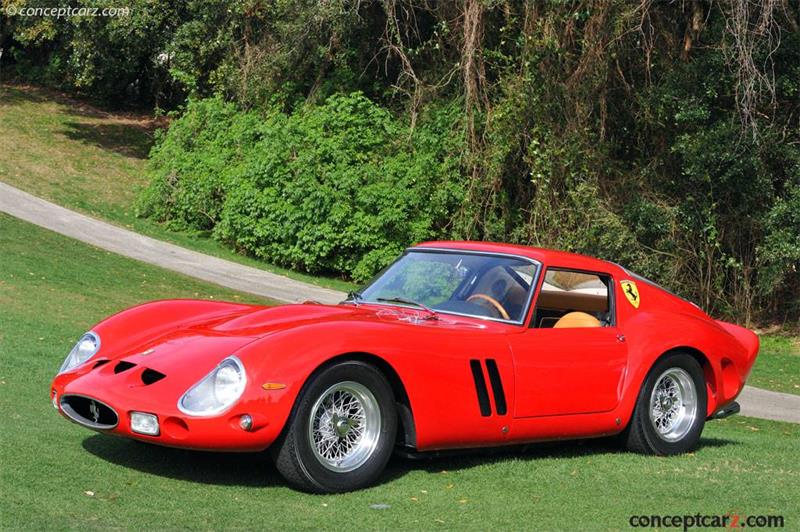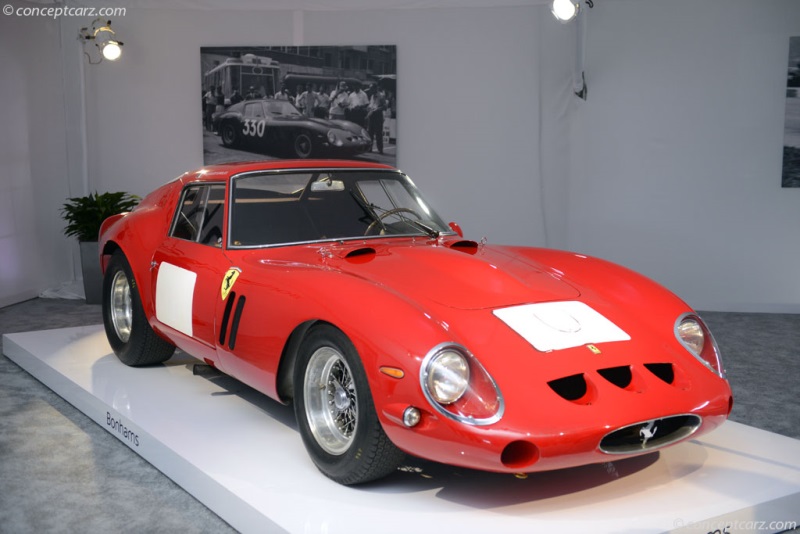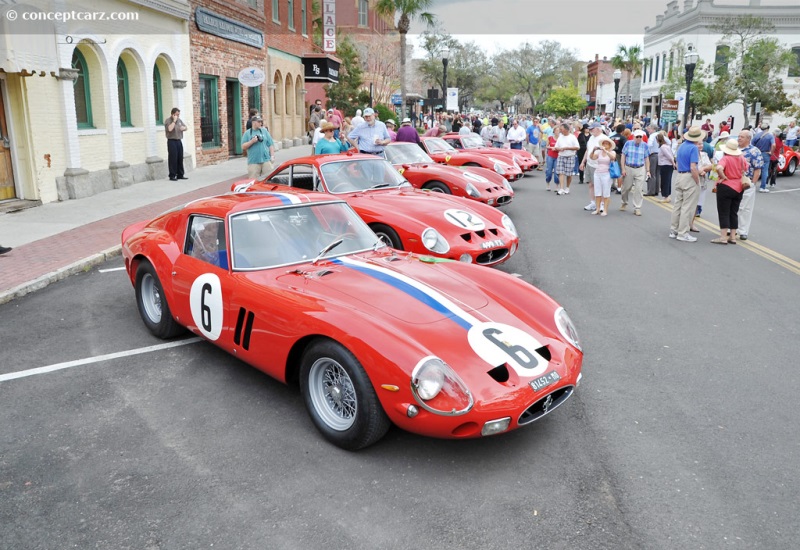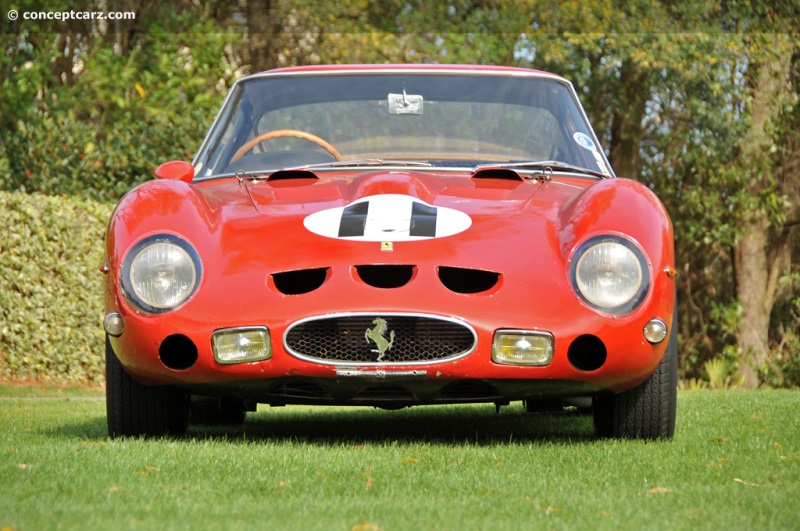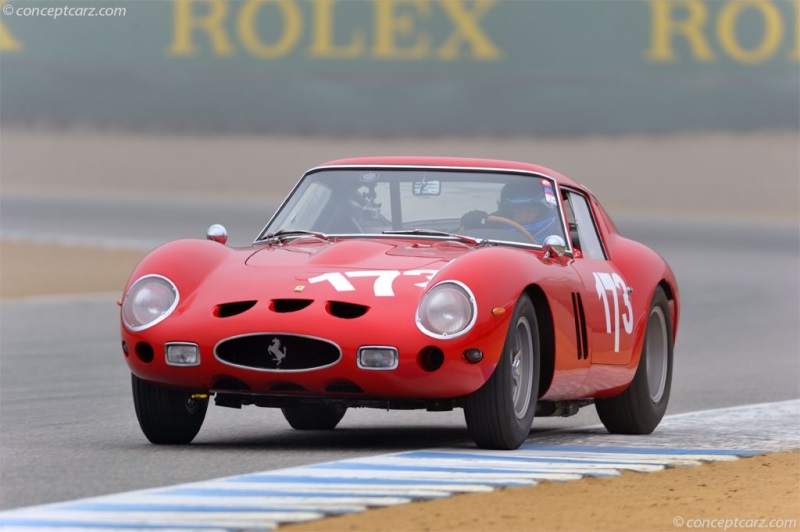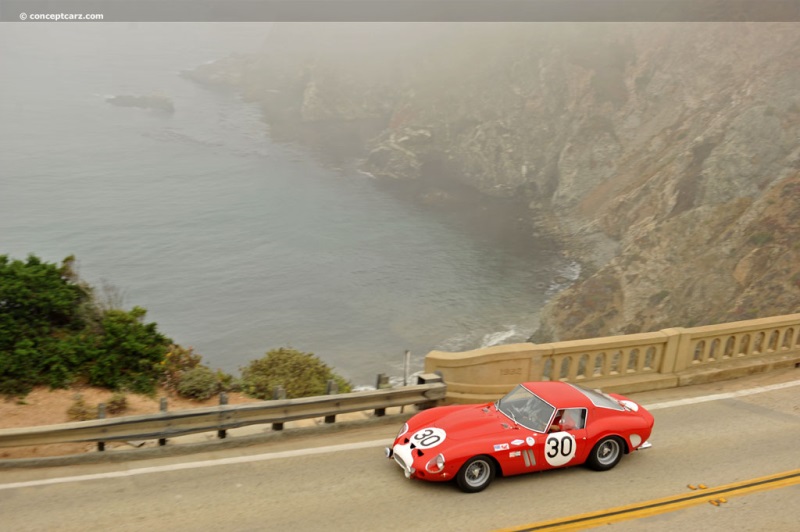The evolution of the Scuderia Ferrari 250 Gran Turismo vehicles of the 1950s and early 1960s reflected the mandates and rule changes imposed by the World Sportscar Championship and the Automobile Club de l'Ouest for the 24 Hours of Le Mans. Introduced in 1952 and produced to 1964, the 250 series of sports cars and grand tourers were designed for both the road and sports car racing. 
Berlinetta CoupeThe 250 Series
The 250 Testa Rossa was among the most successful Ferrari racing cars in its history, with four wins at Sebring, three wins at LeMans, and two wins at Buenos Aires. A 250 GT Berlinetta won the Tour de France Automobile three times in 1956, 1957 and 1958. This streak continued with the later 'Interim' and SWB Berlinettas, with victories in 1959 through 1962.The 250 GT Berlinetta short wheelbase (SWB) was introduced in 1959 and produced through 1961 in both 'Lusso' road car versions with (mostly) steel bodies, and competition examples with aluminum bodies. Engine output ranged from 240 horsepower to 280 horsepower depending on intended use and tuning. The 250 GT SWB continued Ferrari's dominance in GT competition and during the 1960 season, they were nearly unbeatable. Along with victories at the Tour de France, four SWBs claimed the top places in the GT class at Le Mans. The SWB claimed overall or class victories at Spa, Monza, Nürburgring, Monthlery and in the Tourist Trophy.The SWB continued to claim GT class victories through the 1961 season including taking the first four places at the Tour de France. For the following season, the aerodynamic principles of the SWB were improved further, resulting in the 250 GTO ('Gran Turismo Omologato', Italian for 'Homologated Grand Tourer'). Between 1962 and 1963, Ferrari built thirty-six examples. The Series II cars were introduced in 1964 wearing a different body. Three cars were built with the new body, and four of the Series I cars were modified with a Series II body, for a total of 39 GTOs.World Sportscar Championship : GT
The FIA operated the World Sportscar Championship for sports car racing from 1953 to 1992. Until 1961, races included the Targa Florio, Mille Miglia, Carrera Panamericana, 24 Hours of Le Mans, the 12 Hours of Sebring, the Tourist Trophy and Nurburgring 1000 km. Although several manufacturers fielded professional drivers, the majority of the field was comprised of gentleman privateers. The cars were divided into Sports Car and GT (production car) categories and further divided based on the engine displacement size.
Berlinetta Coupe
Chassis #: 3413GT
Engine #: 3413
View info and history
Auction entries : 1Drastic rule changes were introduced for the 1962 season, partly to break up Ferrari's dominant racing campaign and stronghold on the sport. The 1962 World Championship was now run for homologated Grand Turismo cars instead of the purpose-built sports racers of the past. The World Sportscar Championship title was discontinued, being replaced by the International Championship for GT Manufacturers. Cars were now grouped based on the engine size of 'less than one litre,' 'less than two liters,' and 'over two liters.' The following year, a prototype category was added. World Sportscar Championship : Sports Cars
The horrific accident at the 1955 24 Hours of Le Mans had resulted in the FIA's return to emphasizing dual-use grand touring cars and a displacement of 3.0 liters. This introduced a new chapter in the design and build of road-going competition sports cars. While Ferrari was focused on its Grand Prix program during the 1955 season, the Italian Sports Car Championship was won by Armando Zampiero in his Mercedes-Benz 300 SL. Ferrari's response, to the German victor and the FIA's new GT Class Championship, was the dual-purpose road-racing model based on the 250 GT. It wore lightweight aluminum coachwork by Carrozzeria Scaglietti and a competition-tuned three-liter V-12, the resulting 250 GT Berlinetta was a potent force in sports car racing through the late 1950s.
Berlinetta Coupe
Chassis #: 3729GT
View info and historyWith Mercedes-Benz's departure from the sport in 1955, the highest levels of sports car racing were left to Ferrari and Maserati to battle for top honors, with increasing threats from Jaguar, Porsche, and Aston Martin. Ferrari had correctly anticipated a reduction in capacity for sports cars by the CSI for the 1958 season resulting in the 2,953cc, 250 GT, V12 engined Testa Rossa. Ferrari became the only manufacturer to field a competitive car during the early part of the 1958 season, with the sole competition coming from privately entered Maserati 300 S machines, but not to the same extent as the prior year. Maserati had withdrawn from competition following the Venezuela Grand Prix in 1957 which had proven to be a disastrous race for the team. As the season progressed, so did the competition, especially from the Aston Martin DBR1 which won the Nurburgring 1000 Km. Apart from 1955 which was won by Mercedes-Benz, Ferrari won the World Championship for Sports cars from 1953 through 1958. Aston Martin won in 1959, with the DBR1 winning three of the five races, a Porsche 718 winning the Targa Florio, and Ferrari scoring a sole victory at the Sebring. Aston Martin did not return to defend their title in 1960, leaving Scuderia Ferrari to reclaim the title. It was far from an easy season, as the Porsche 718 RS won twice and a Maserati Tipo 61 won once. Ferrari had won the season opener at Buenos Aires with the 250 TR 59/60, but in order to beat Porsche, they would have to win at the final event of the season, the 24 Hours of LeMans. The powerful 3.0-liter Ferraris were able to capture six of the top seven positions, securing the 1960 championship for Scuderia Ferrari.
Berlinetta Coupe
Chassis #: 3705GT
View info and historyFerrari won four out of five races in 1961. The 250 GTO
With FIA's decision to run the 1962 World Championship for GT cars, rather than sports cars, Ferrari focused on transforming the 250 GT SWB from a class to an overall contender. This entailed improvements to the 250 GT SWB aerodynamics at high speed and the installation of a dry-sump 250 TR engine with six Weber carburetors, which required homologation. A 'Sperimentale' was raced in the 1961 Le Mans race, and although it was fast, it failed to finish. Work continued through 1961 and into the 1962 with Gestione Sportiva's Giotto Bizzarrini in charge of the project. Although not in its finished form, the '250 SWB Comp/62' was shown in February of 1962 to the press. During his speed tests the design proved unstable, so a small lip, known as a 'Kamm' tail, was added to the back. The first 18 cars received a bolt-on 'Kamm tail' lip while the remaining examples had it designed directly into the body. The design was a drastic change from the previous year's model and many speculated that it would fail to be homologated. Ferrari, however, had received approval for each of the changes separately, and the car cleared homologation. The official paperwork labeled it the 250 GT Comp/62, however, it has become known as the 250 GTO, with the 'O' short for 'Omologato.'
Berlinetta Coupe
Chassis #: 3445GT
View info and historyDevelopment was slowed by the infamous walk-out in 1961 by many Ferrari employees including Bizzarrini. Work continued under the leadership of Mauro Forghieri but it was not ready in time for the season opener at the 3 Hours of Daytona, leaving the racing duties to the 250 GT SWB of the N.A.R.T. racing team. The next round of the championship was at Sebring, where the GTO driven by Phil Hill and Olivier Gendebien won the GT class. It would win the remainder of the world championship GT class races, including a 1st through 3rd place finish in the GT class at Le Mans. For the 1963 season, the 250 GTO faced increased competition from the Shelby Cobras but not enough to deprive the GTO of the GT Championship for the second year in a row. For the 1964 season, Ferrari had hoped its mid-engined 250 LM would be homologated for GT racing. It was a development of the 1963 Le Mans-winning 250 P, but its radical departure from the prior 250 series resulted in its denial of homologation by the FIA. So Ferrari built three new GTOs, commonly referred to as the 'Series 2', with Pininfarina styling influenced by the 250 LM. Between 1962 and 163, Ferrari built 32 cars with the Comp/62 design. For the 1963 24 Hours of Le Mans race, Luigi Chinetti's North American Racing Team created a special-bodied example of the 250 GTO and is commonly known as the 250 GTO LMB. With the three 'Series 2' cars, this brought the total 250 GTO's to 36. 3 additional 'GTO' cars were built with a slightly larger chassis and a more powerful 4-liter engine. These three cars are known as the 330 GTOs. Four cars were later brought back to the factory to be fitted with the 1964 body style. Three cars were originally built with the 1964 body. 
Berlinetta Coupe 64 by Scaglietti
Chassis #: 4091GT
View info and historySince the creation of the 250 GTO in the early 1960s, they have gained ever-increasing interest and admiration from the car connoisseur and art investors alike. The relatively few examples that have come to market over the years have demanded astronomical figures, eclipsing previous records, with prices exceeding $40 and $50 million (USD).
by Daniel Vaughan | Apr 2020

Berlinetta Coupe
The 250 Testa Rossa was among the most successful Ferrari racing cars in its history, with four wins at Sebring, three wins at LeMans, and two wins at Buenos Aires. A 250 GT Berlinetta won the Tour de France Automobile three times in 1956, 1957 and 1958. This streak continued with the later 'Interim' and SWB Berlinettas, with victories in 1959 through 1962.The 250 GT Berlinetta short wheelbase (SWB) was introduced in 1959 and produced through 1961 in both 'Lusso' road car versions with (mostly) steel bodies, and competition examples with aluminum bodies. Engine output ranged from 240 horsepower to 280 horsepower depending on intended use and tuning. The 250 GT SWB continued Ferrari's dominance in GT competition and during the 1960 season, they were nearly unbeatable. Along with victories at the Tour de France, four SWBs claimed the top places in the GT class at Le Mans. The SWB claimed overall or class victories at Spa, Monza, Nürburgring, Monthlery and in the Tourist Trophy.The SWB continued to claim GT class victories through the 1961 season including taking the first four places at the Tour de France. For the following season, the aerodynamic principles of the SWB were improved further, resulting in the 250 GTO ('Gran Turismo Omologato', Italian for 'Homologated Grand Tourer'). Between 1962 and 1963, Ferrari built thirty-six examples. The Series II cars were introduced in 1964 wearing a different body. Three cars were built with the new body, and four of the Series I cars were modified with a Series II body, for a total of 39 GTOs.World Sportscar Championship : GT
The FIA operated the World Sportscar Championship for sports car racing from 1953 to 1992. Until 1961, races included the Targa Florio, Mille Miglia, Carrera Panamericana, 24 Hours of Le Mans, the 12 Hours of Sebring, the Tourist Trophy and Nurburgring 1000 km. Although several manufacturers fielded professional drivers, the majority of the field was comprised of gentleman privateers. The cars were divided into Sports Car and GT (production car) categories and further divided based on the engine displacement size.
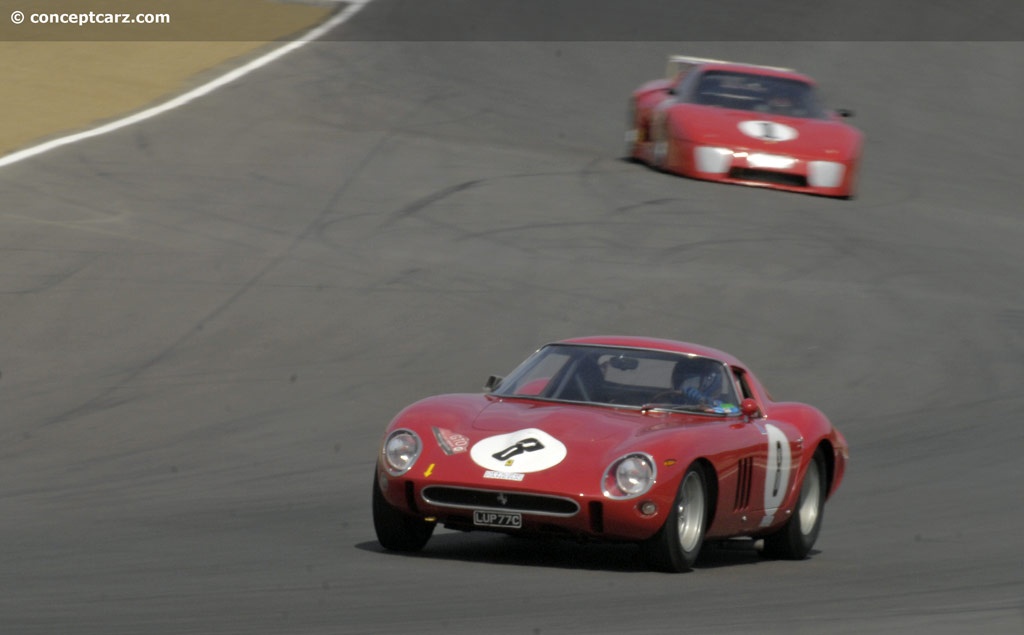
Berlinetta Coupe
Chassis #: 3413GT
Engine #: 3413
View info and history
Auction entries : 1
The horrific accident at the 1955 24 Hours of Le Mans had resulted in the FIA's return to emphasizing dual-use grand touring cars and a displacement of 3.0 liters. This introduced a new chapter in the design and build of road-going competition sports cars. While Ferrari was focused on its Grand Prix program during the 1955 season, the Italian Sports Car Championship was won by Armando Zampiero in his Mercedes-Benz 300 SL. Ferrari's response, to the German victor and the FIA's new GT Class Championship, was the dual-purpose road-racing model based on the 250 GT. It wore lightweight aluminum coachwork by Carrozzeria Scaglietti and a competition-tuned three-liter V-12, the resulting 250 GT Berlinetta was a potent force in sports car racing through the late 1950s.
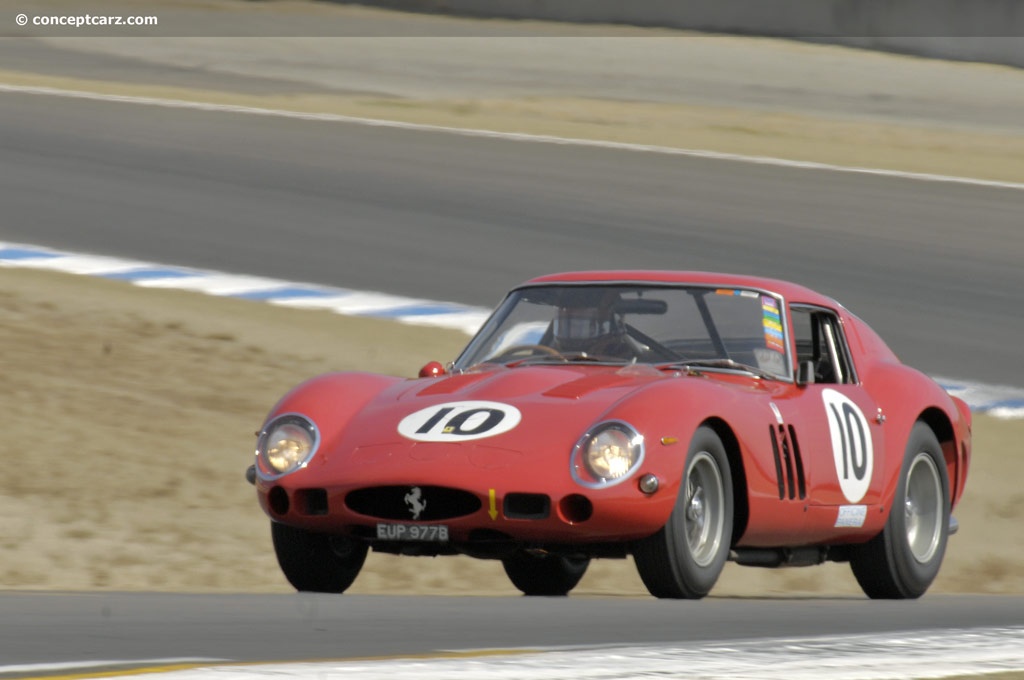
Berlinetta Coupe
Chassis #: 3729GT
View info and history
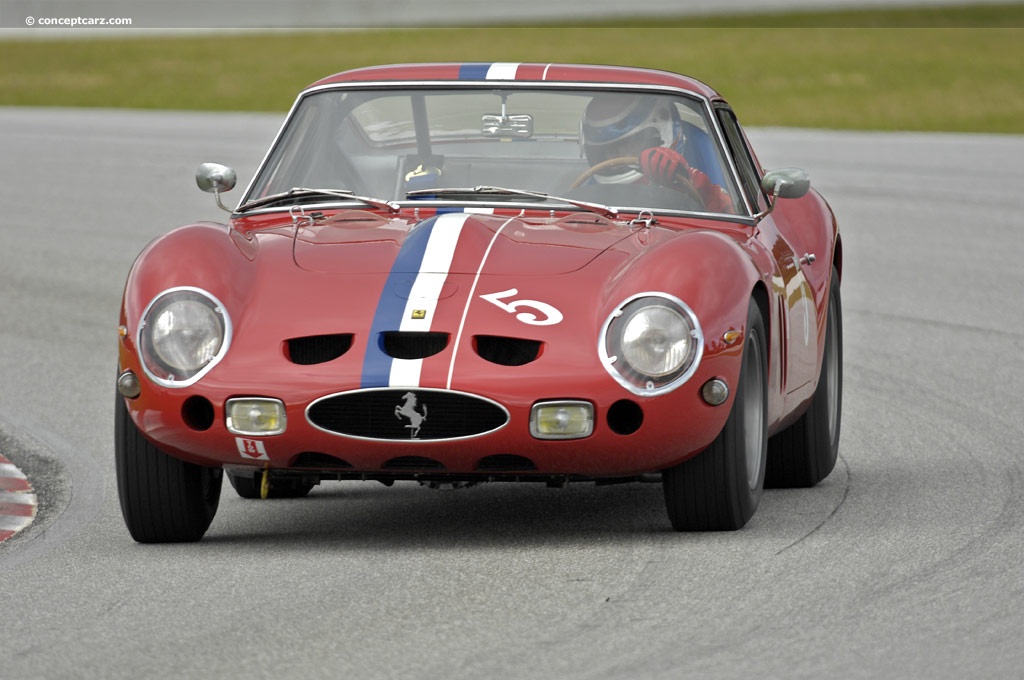
Berlinetta Coupe
Chassis #: 3705GT
View info and history
With FIA's decision to run the 1962 World Championship for GT cars, rather than sports cars, Ferrari focused on transforming the 250 GT SWB from a class to an overall contender. This entailed improvements to the 250 GT SWB aerodynamics at high speed and the installation of a dry-sump 250 TR engine with six Weber carburetors, which required homologation. A 'Sperimentale' was raced in the 1961 Le Mans race, and although it was fast, it failed to finish. Work continued through 1961 and into the 1962 with Gestione Sportiva's Giotto Bizzarrini in charge of the project. Although not in its finished form, the '250 SWB Comp/62' was shown in February of 1962 to the press. During his speed tests the design proved unstable, so a small lip, known as a 'Kamm' tail, was added to the back. The first 18 cars received a bolt-on 'Kamm tail' lip while the remaining examples had it designed directly into the body. The design was a drastic change from the previous year's model and many speculated that it would fail to be homologated. Ferrari, however, had received approval for each of the changes separately, and the car cleared homologation. The official paperwork labeled it the 250 GT Comp/62, however, it has become known as the 250 GTO, with the 'O' short for 'Omologato.'
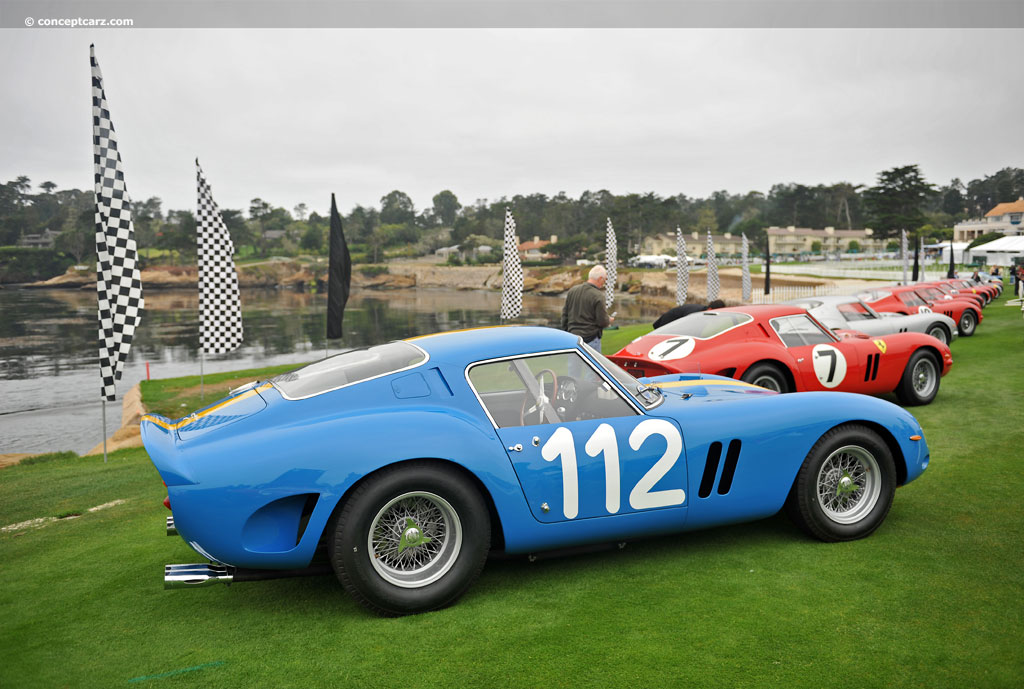
Berlinetta Coupe
Chassis #: 3445GT
View info and history
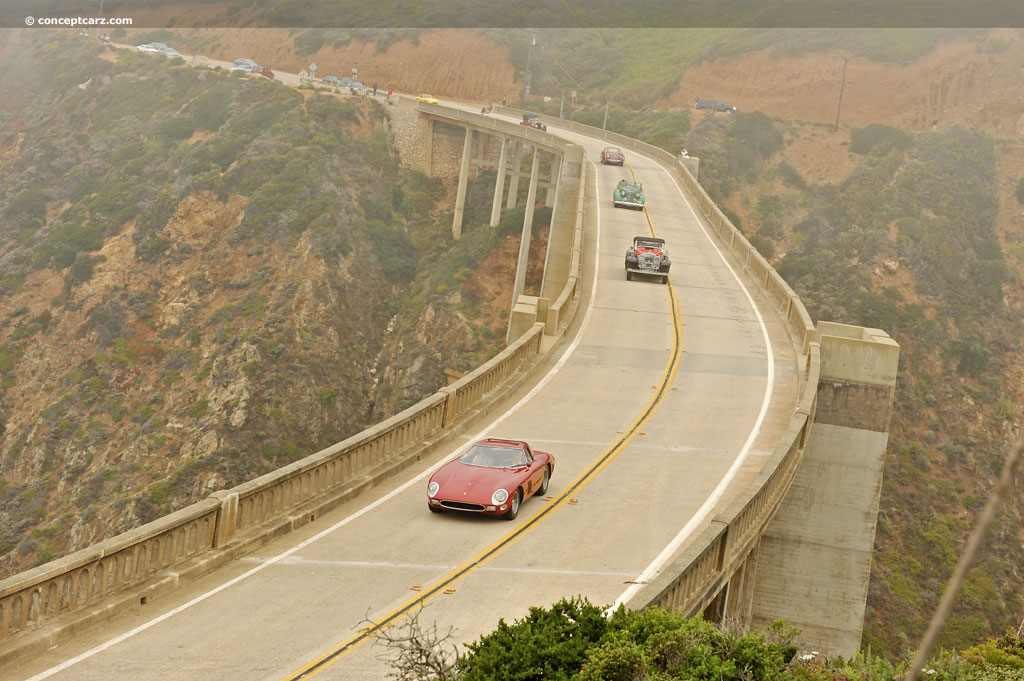
Berlinetta Coupe 64 by Scaglietti
Chassis #: 4091GT
View info and history
by Daniel Vaughan | Apr 2020
Related Reading : Ferrari 250 GTO History
The Ferrari 250 GTO was produced from 1962 through 1964 with 36 examples created during that time including 33 cars with the 1962 and 1963 Series I bodywork and three with 1964 (Series II) bodywork similar to the Ferrari 250 LM. Four of the Series I cars were later updated in 1964 with Series II bodies. The 250 GTO is a car of beauty, performance, and mystery. Much is known about the car, but much....
Continue Reading >>
Continue Reading >>
Related Reading : Ferrari 250 GT History
Production of the 250 Series began in 1954 and continued on through the early part of the 1960s. There were numerous variations of the 250 and would ultimately become Ferraris most successful line of vehicles to date. The 250 is also recognized as the first Ferrari to ever receive disc brakes. This did not take place until the end of the 1950s. Also, the 250 was the first four-seater. Ferraris....
Continue Reading >>
Continue Reading >>
1962 Ferrari 250 GTO Vehicle Profiles
Recent Vehicle Additions
Related Automotive News

1962 Ferrari 250 GTO and 1947 Delahaye 135MS Narval Cabriolet Named Best in Show at The Amelia
A 1962 Ferrari 250 GTO was crowned Best in Show, Concours de Sport while a 1947 Delahaye 135MS Narval Cariolet took home Best in Show, Concours dElegance at the 29th annual Amelia Island Concours dElegance. The Sunday Concours concluded a...

The Most Valuable Car Ever Sold At Auction: RM Sotheby's Sells 1962 Ferrari 250 Gto For $48.2 Million
Exceeds Previous Record By Over %2410 Million
Follows Friday Night Sale of 1963 Aston Martin DP215 For %2421.5 Million
RM Auto Restoration will present three cars on the lawn at Pebble Beach on Sunday, 26 August
Complete results from RM Sotheby...

The Most Valuable Car Ever Offered at Auction - 1962 Ferrari 250 GTO to Headline RM Sotheby's Monterey
1962 FERRARI 250 GTO TO HEADLINE RM SOTHEBYS FLAGSHIP MONTEREY SALE
The Holy Grail highly original, numbers-matching 1962 Ferrari 250 GTO set to star at RM Sothebys Monterey sale, 24-25 August
One of just 36 built, the GTO boasts succes...

The 55th anniversary of the 250 GTO
The rally marking the 55th anniversary of the Ferrari 250 GTO, one of the most iconic cars ever built both in terms of its design and for the wins it collected at some of the worlds most important tracks and races, concluded at the factory in Maranello...

Ferrari 250 GTO leads collection of the world's rarest Ferraris at Concours of Elegance
Concours of Elegance to assemble finest selection of classic Ferraris ever seen in UK to celebrate marques 75th birthday.
Jaw dropping line-up up to include hallowed one-of-36 250 GTO, perhaps the worlds most sought-after car
Other stunning Fer...

Motoring royalty at Blenheim Palace as Salon Privé welcomes Ferrari 250 GTOs
Two legendary GTOs will be on display during Salon Privé Week, 1-5 September
Chassis numbers 3767GT and 4399GT boast superb competition history
Only 36 Ferrari 250 GTOs were built and theyre now among the most coveted and valuable of all collecto...

Ferrari: Under The Skin
15 November 2017 - 15 April 2018
Major exhibition announced by the Design Museum in London to mark the 70th anniversary of Ferrari
£140M worth of Ferraris featured in exhibition displaying cars driven by racing drivers Peter Collins and Stir...
Scuderia Ugolini: 1959 Formula One Season
While the name Ferrari is recognized the world-over, Ugolini, on the other hand, is only a name recognized by those very knowledgeable of motor racing and football. However, the name is nearly as vitally important to the world of motor sport. In 1959,...

H&H CLASSICS TO SELL TWO MULTI-MILLION FERRARIS IN GENEROUS LEGACY TO THE RNLI
H%26H Classics to offer a 1960 Ferrari 250 GT SWB and 1967 Ferrari 275 GTB4 from the estate of the late Richard Colton, a pre-eminent British V12 Ferrari collector
Proceeds from the sale to benefit the Royal National Lifeboat Institution
1960 Ferra...




































